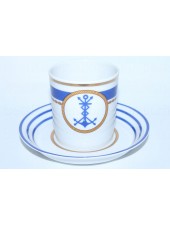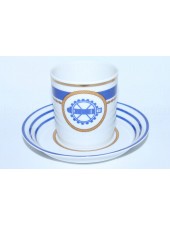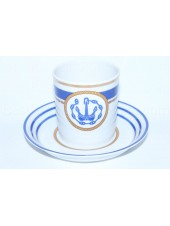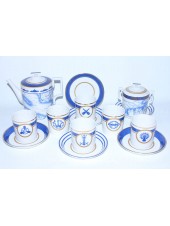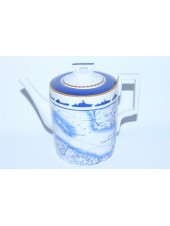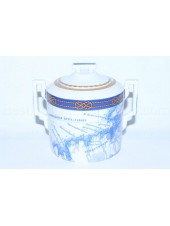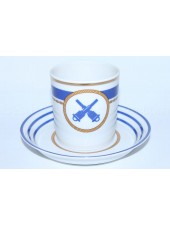Wardroom set. The history of creating.
- 30 June 2016 06:28:47
- Views: 7560
St. Petersburg Imperial Porcelain Factory has long been cooperating with many famous people. Some time ago Yevgeni Grishkovetz Yevgeni Grishkovetz (born in 1967), a popular Russian writer, dramatist, stage director, actor and musician, was asked to think about a certain idea of the author's porcelain products.
He was really interested in creation of a tea set, which would have looked like quite classic, which if successful would have been sold for many years, and would take its place in homes and, most importantly, in lives of many people. “I thought about it and realized I would like to have a tea set on a naval theme. I would not like to have a set, decorated with something timeless or unspecific. On the contrary, I would like it to be a tableware, reminding me of my years of service and a large fleet, which once we had,” said Yevgeni.
Imperial Porcelain Factory quickly responded with interest and attention to the proposal. It turned out that neither in the Soviet period of the factory or in recent years, the set to the naval theme has never existed. At the same time, there are a lot of people in the country who might want to have such dishes. And they are not only those who served in the Navy or are serving. They are not only descendants or relatives of sailors, but people who just like military history and especially its naval page. Finally, it may be a great gift not only to a sailor, but to a person who lives in a city with naval history. An artist Vera Bakastova worked with Yevgeni. This is her who defined the form of cups, a teapot and other items. It is a classic shape, designed a long time ago. Shape "Gerbovaya" was created at the Imperial Porcelain Factory for a tea set in the middle of the XIX century and restored at the Lomonosov Porcelain Factory in 1996. Yevgeni spoke about symbolism of various marine specialties. And finally they got an amazing product. The service consists of six saucers, six cups, a milk jug(purchased separately), a sugar bowl and a teapot. The teapot is decorated with maps of water areas of Kronstadt and Vladivostok, on the sugar bowl, you will see the map of the coast of the Barents Sea with the city of Murmansk, as well as the map of Sevastopol Bay. The service thus expresses honor to sailors of all four fleets: the Pacific, the Baltic, the Northern and the Black Sea. The milk jug is dressed in something like a vest. Six cups are adorned with six "states", a kind of emblems of main naval combat units (CU), or main naval specialties. A steering wheel on the cup means navigators. Crossed guns mean artillery. Torpedoes mean mine and torpedo group (the specialty of Yevgeni Grishkovetz). An anchor means a variety of wireless operators. Gears and screw mean minders, mechanics and all others who are associated with the running of the ship. A beautiful anchor chain is a boatswain's team. The name of the set "Wardroom" is written at the bottom of the teapot. And above this inscription there is a small double-headed eagle, which decorates a lot of fine works of the Imperial Porcelain Factory.
“I regard this inscription and coat of arms, and I cannot believe that I have been able to take part in it. I like that the set looks strict, classical, traditional for the factory, very thoughtful, and that there are no accidental or contrived details”, said Yevgeni.
Yevgeni Grishkovetz web-site materials were used
He was really interested in creation of a tea set, which would have looked like quite classic, which if successful would have been sold for many years, and would take its place in homes and, most importantly, in lives of many people. “I thought about it and realized I would like to have a tea set on a naval theme. I would not like to have a set, decorated with something timeless or unspecific. On the contrary, I would like it to be a tableware, reminding me of my years of service and a large fleet, which once we had,” said Yevgeni.
Imperial Porcelain Factory quickly responded with interest and attention to the proposal. It turned out that neither in the Soviet period of the factory or in recent years, the set to the naval theme has never existed. At the same time, there are a lot of people in the country who might want to have such dishes. And they are not only those who served in the Navy or are serving. They are not only descendants or relatives of sailors, but people who just like military history and especially its naval page. Finally, it may be a great gift not only to a sailor, but to a person who lives in a city with naval history. An artist Vera Bakastova worked with Yevgeni. This is her who defined the form of cups, a teapot and other items. It is a classic shape, designed a long time ago. Shape "Gerbovaya" was created at the Imperial Porcelain Factory for a tea set in the middle of the XIX century and restored at the Lomonosov Porcelain Factory in 1996. Yevgeni spoke about symbolism of various marine specialties. And finally they got an amazing product. The service consists of six saucers, six cups, a milk jug(purchased separately), a sugar bowl and a teapot. The teapot is decorated with maps of water areas of Kronstadt and Vladivostok, on the sugar bowl, you will see the map of the coast of the Barents Sea with the city of Murmansk, as well as the map of Sevastopol Bay. The service thus expresses honor to sailors of all four fleets: the Pacific, the Baltic, the Northern and the Black Sea. The milk jug is dressed in something like a vest. Six cups are adorned with six "states", a kind of emblems of main naval combat units (CU), or main naval specialties. A steering wheel on the cup means navigators. Crossed guns mean artillery. Torpedoes mean mine and torpedo group (the specialty of Yevgeni Grishkovetz). An anchor means a variety of wireless operators. Gears and screw mean minders, mechanics and all others who are associated with the running of the ship. A beautiful anchor chain is a boatswain's team. The name of the set "Wardroom" is written at the bottom of the teapot. And above this inscription there is a small double-headed eagle, which decorates a lot of fine works of the Imperial Porcelain Factory.
“I regard this inscription and coat of arms, and I cannot believe that I have been able to take part in it. I like that the set looks strict, classical, traditional for the factory, very thoughtful, and that there are no accidental or contrived details”, said Yevgeni.
Yevgeni Grishkovetz web-site materials were used


/Y.Grishkovetz1-580x300.jpg)
/Y.Grishkovetz2-105x140.jpg)
/Y.Grishkovetz3-105x140.jpg)
/Y.Grishkovetz4-105x140.jpg)
/Y.Grishk05-105x140.jpg)
/Y.Grishk06-105x140.jpg)
/Y.Grishk07-105x140.jpg)
/Y.Grishk08-105x140.jpg)
/Y.Grishk09-105x140.jpg)
/Y.Grishk10-105x140.jpg)

